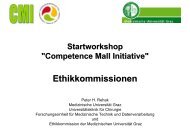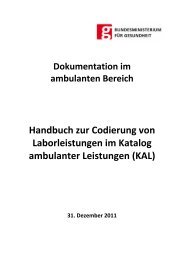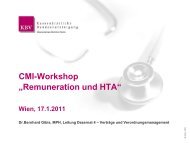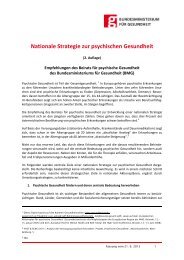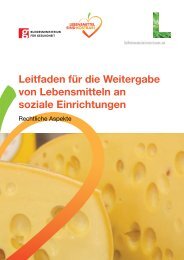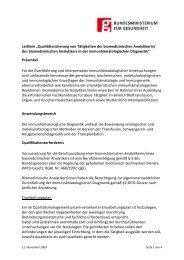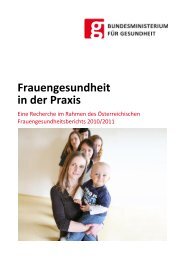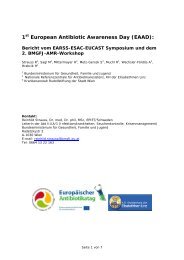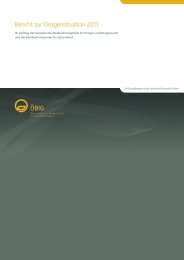Report on the Drug Situation 2010 - Bundesministerium für ...
Report on the Drug Situation 2010 - Bundesministerium für ...
Report on the Drug Situation 2010 - Bundesministerium für ...
- No tags were found...
You also want an ePaper? Increase the reach of your titles
YUMPU automatically turns print PDFs into web optimized ePapers that Google loves.
approximati<strong>on</strong>s and have to be interpreted with cauti<strong>on</strong>. The prevalence rate of alcoholdependence, compared to illicit drugs, is estimated to be 5% of <strong>the</strong> populati<strong>on</strong> over 15in Austria. This means that a total of 350 000 people in Austria are to be regarded asalcoholics (Uhl et al. 2009).4.1 Prevalence and incidence estimates of PDUIn Austria scientific estimates of <strong>the</strong> prevalence of problem drug use are <strong>on</strong>ly availablefor opioids and for poly-drug use with opioids. GÖG/ÖBIG has updated <strong>the</strong> estimateswhich so far have been available up to 2007 (GÖG/ÖBIG <strong>2010</strong>b): now <strong>the</strong> years 2008and 2009 are covered as well (GÖG/ÖBIG, under preparati<strong>on</strong>). For <strong>the</strong> capture-recapturemethod, <strong>on</strong> which <strong>the</strong> prevalence estimate is based, data <strong>on</strong> opioidsubstituti<strong>on</strong> treatment and reports to <strong>the</strong> police relating to opioids were used.However, <strong>the</strong> problem of ghost cases is a significant deficit regarding <strong>the</strong> quality ofsubstituti<strong>on</strong> data 15 .In order to correct <strong>the</strong> resulting bias, i.e., <strong>the</strong> tendency to overestimate prevalencerates, data from <strong>the</strong> year 2004 were used to derive a correcti<strong>on</strong> formula (GÖG/ÖBIG<strong>2010</strong>b). Figure 4.1 shows <strong>the</strong> time series of prevalence estimates with and without acorrecti<strong>on</strong> for ghost cases. When interpreting <strong>the</strong>se figures <strong>on</strong>e has to bear in mindthat <strong>the</strong> correcti<strong>on</strong> factor calculated for <strong>the</strong> year 2004, due to correcti<strong>on</strong> routines in<strong>the</strong> substituti<strong>on</strong> registry (see Chapter 5.4), may assume a number of ghost cases thatis too high, which in turn leads to underestimates of prevalence rates. For this reas<strong>on</strong>,<strong>the</strong> estimated current prevalence of problem drug use including opioid use in 2009can <strong>on</strong>ly be given as a fairly rough approximati<strong>on</strong>: between 25 000 and 37 000 people(prevalence estimate corrected for ghost cases in 2009: 25 777; 95% c<strong>on</strong>fidence interval:24 867—26 687; prevalence estimate without correcti<strong>on</strong> for ghost cases in 2009:35 252; 95% c<strong>on</strong>fidence interval: 33 976—36 529). If <strong>the</strong>se figures are combined witho<strong>the</strong>r data sources, it is safe to assume that <strong>the</strong> prevalence rates of PDU, after a rise in2004, have g<strong>on</strong>e down again and have remained at similar levels in recent years (fordetails see GÖG/ÖBIG 2008c and GÖG/ÖBIG <strong>2010</strong>b). For 2007, <strong>the</strong> results of <strong>the</strong> twosampleCRC estimates could be verified to a large extent by means of a three-sampleCRC estimate which included drug-related deaths (GÖG/ÖBIG, under preparati<strong>on</strong>).15If <strong>the</strong> end of treatment is not documented, <strong>the</strong> corresp<strong>on</strong>ding clients appear in <strong>the</strong> statistics as people currentlyundergoing treatment also in <strong>the</strong> years after <strong>the</strong> actual end of treatment (= ghost cases).28 © GÖG/ÖBIG, <str<strong>on</strong>g>Report</str<strong>on</strong>g> <strong>on</strong> <strong>the</strong> <strong>Drug</strong> Situati<strong>on</strong> <strong>2010</strong>



